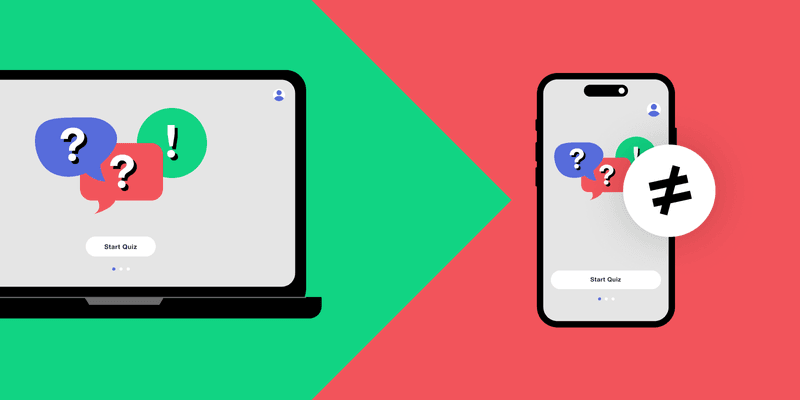Wasted ad spend is only part of the problem.
Building the wrong funnel burns developer hours, design resources, and senior stakeholder time — all for something that might not even be the best approach.
Worst of all? You might come to the completely wrong conclusion that web-to-app funnels “don’t work” for your business… when in reality, you just didn’t explore all the options.
I see it happen all the time.
A subscription app copies a web-to-app funnel from a big-name competitor, assuming that’s the “proven” model. After three months, it’s underperforming.
What happens next?
- Half of the team blames the creatives.
- Half of the team blames poor tracking.
- The C-suite blames web-to-app itself.
The truth? They may have just picked the wrong strategy.
If you think web-to-app = onboarding quizzes, keep reading, because that assumption might be the most expensive web-to-app mistake you make this year.
Who I am and why this matters
Hey, I’m Nathan Hudson, App Marketer of the Year, and Founder of Perceptycs, where we help subscription apps grow faster. I’ve worked with indie developers grinding it out, VC-backed startups chasing hockey-stick growth, bootstrapped scale-ups fighting for every dollar, and even large enterprises trying to innovate like startups.
Across all of the conversations I’ve had, one assumption pops up over and over again.
The misconception: web-to-app funnels = web onboarding quizzes
Most people think that web-to-app = web onboarding quizzes.
They assume that to make web-to-app work, you need a web onboarding journey that feels like a personality test. “What’s your biggest challenge?” “What are your goals?” “Which celebrity do you think you’d be if they were an inanimate object?”
Now, don’t get me wrong, these onboarding journeys can work, and in a lot of cases too. We’ve helped countless apps refine their web-to-app quiz funnels. But they’re not the only way.
And if that assumption goes unchallenged, it kills experimentation, limits growth, and burns budgets.
Why this assumption exists
So why is this misconception so prevalent? There are a couple of key reasons:
Reason #1: Big apps have normalized it
Apps like Calm, Blinkist, Duolingo, and Headway have been running web onboarding funnels for years. And these are the giants of the app world that most growth teams look up to.
Smaller apps copy them, assuming that’s the way to make web-to-app work. They see the success of these big brands and think, “If it works for them, it’ll work for me.”
App teardowns (including my own) reinforce this because they often focus on these best in class, industry leaders. The reason for that is because breakdowns of big apps get more attention than smaller niche funnels that don’t have huge scale. Everyone wants to know what Calm is doing, but nobody cares about “Bob’s Discount Meditation App” (no offense to Bob).
So, the quiz funnel gets all the attention, even though it might not be the best fit for every app.
But apps that see success with web-to-app onboarding journeys are often Health & Fitness apps, or Education apps. They often already have seen success with long onboarding journeys in app and they have a plethora of reasons to ask users questions (narrowing down use cases, content personalisation, etc)
Reason #2: The rise of web onboarding funnel builders
The rise of drag-and-drop web onboarding funnel builders has also contributed to this misconception. Many of the most visible tools in the space position themselves as “Web-to-App made easy,” but, if you look closer, their offerings almost always center on onboarding quizzes — a narrow subset of what’s possible.
Of course, it’s a classic case of building what sells: most teams ask for quiz funnels, so these platforms double down on them. But by only offering one approach, they end up reinforcing the idea that web-to-app = quizzes, limiting the scope of experimentation and nudging the market toward a single, cookie-cutter solution.
Why this misconception is dangerous
Here’s why this misconception is so dangerous: If you believe web-to-app = Quizzes, you limit yourself to one playbook. You’re putting all your eggs in one basket, and that’s never a good idea.
- If it doesn’t work for your app, you’ll assume web-to-app doesn’t work for your app. And this might not be the case. All you’ve proved is that web-to-app onboarding funnels don’t work for you. And more specifically, the web-to-app onboarding quizzes you’ve tested in your current setup/funnel don’t work for you. And you’ll miss out on all the other potential benefits of web-to-app funnels.
- Even if it’s working now, it won’t last forever. Marketing trends cycle. We’ve seen it happen time and time again.
Something works → People copy it → Tools make it easier → More people copy → The market gets saturated → Performance tanks. It’s the marketers circle of life.
We saw it with banner ads, we see it with ad fatigue, and we’ll see it with onboarding quizzes. Eventually, people will get tired of answering questions and they’ll start tuning out. And then what?
When web-to-app quizzes don’t click (recognizing the wrong fit)
Okay. So the obvious next question is – when might a quiz funnel not be the right fit?
I find it helpful to break down what types of apps typically see success with web-to-app funnels and try to understand why that might be. What purpose is the onboarding funnel serving for them and their users?
Then we can simply reverse this and start with the assumption that if we don’t need to achieve those things, we may not need a
But for the sake of time, here are a few of those core reasons:
- Limited need for personalization: Onboarding funnels allow you to capture data which can then be leveraged to personalise the early product experience and filtering down features/content. But what if your app doesn’t need deep personalization? What if it’s a simple photo inbox cleaner app? A quiz is just unnecessary friction.
- Lack of nuance: Onboarding funnels are great for teaching users about nuanced topics and taking them on a journey where the aha mo. But what if your app is incredibly straightforward? What if it’s a simple weather app? A quiz is just overkill.
- No need for empathy building: Onboarding funnels are a great way to build and communicate a sense of empathy from the app to the user. It’s essentially a way of saying, we care about you, we understand and we want to go on this journey together. But what if your app doesn’t need to build that kind of emotional connection? What if it’s a simple tool? Well. Then a quiz is just… weird.
- Simple value proposition: If your app’s value is immediately obvious, a quiz just delays the user from experiencing it. Why make them jump through hoops when they could be getting value right away?
- High friction introduction: Let’s face it: Quizzes can feel intrusive or time-consuming if not done well. They can deter users before they even get a chance to see what your app is all about.
The truth: web-to-app is bigger than just quizzes
Here’s the reality: web-to-app is simply the process of using the web to aid mobile app conversion.
It’s about leveraging the web as part of the user conversion journey.
You don’t need quizzes. You don’t even technically need account creation or a web checkout to launch a web-to-app funnel.
Here are just a few other viable web-to-app strategies:
- Landing page → Checkout
- Landing page → Sign up → Install
- Smart banners (AppsFlyer, Adjust, etc.)
- QR codes → App Install
- Email sequence → Web Paywall → Checkout
- Lead magnet → App install
- Blog post → Install
- Webinar funnel → Checkout
- Landing page → Web app demo → Checkout
And tons more… The possibilities are endless! It’s about thinking creatively and finding what works for your product and your audience.
So what should you do?
If your quiz funnel is working – amazing! Double down on it. But also start thinking through whether or not any other web-to-app strategies could be worth testing for your app. Perhaps they could be integrated into your existing funnel or maybe launched as separate funnel tests all together.
Ultimately the goal is to scale efficiently. Some of these alternatives might very well deliver stronger performance for your app. And others may enable you to reach new audiences or convert prospects with different intent.
If your funnel isn’t working, split your resources between optimising what you have and testing new ideas. You most likely have hypotheses around why the funnel isn’t performing and insights from performance so far. Leverage these to both iterate on your quiz funnel and test different types of web-to-app funnels.
Of course the ultimate goal is to have a profitable web-to-app funnel. But from where you stand right now, an immediate goal should be to figure out whether or not it’s the way you’ve tested quiz funnels, the quiz funnel itself or web-to-app as a whole. But beyond this
If you haven’t started yet, don’t just copy what everyone else is doing – think through what makes sense for your product. What are your unique selling points? What are your customers’ pain points? How can you best highlight and address those on the web before they even download your app?
It might not be a web onboarding quiz.

